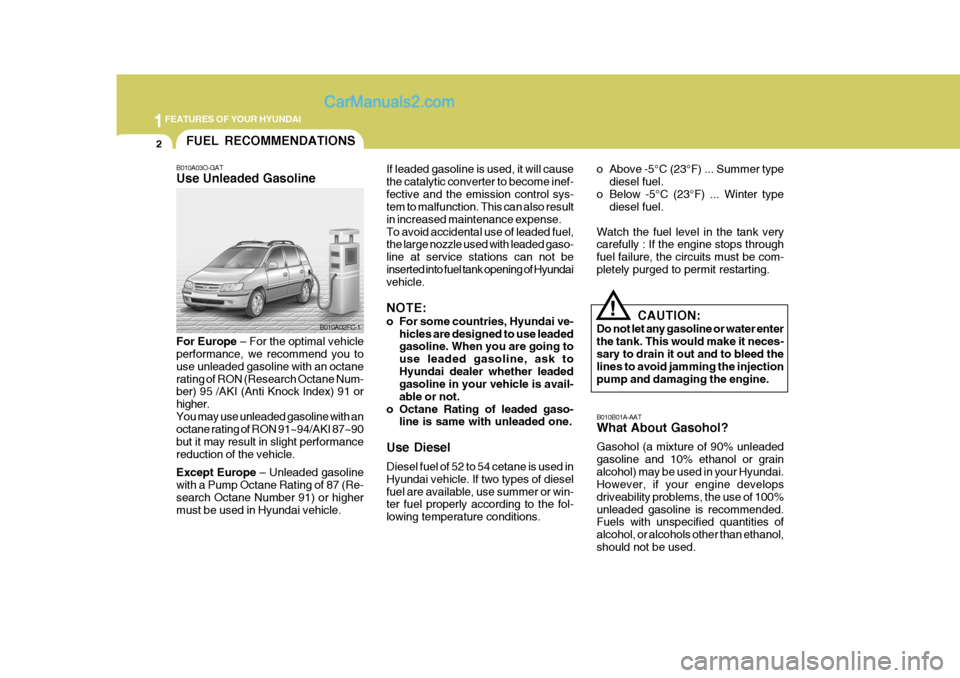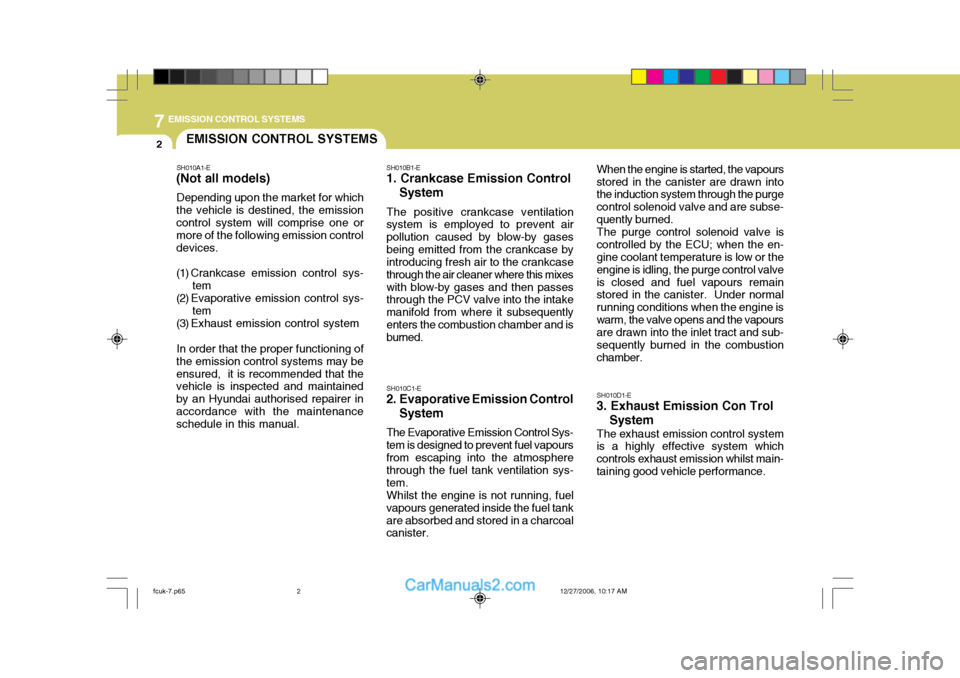open gas tank Hyundai Matrix 2007 Owner's Manual
[x] Cancel search | Manufacturer: HYUNDAI, Model Year: 2007, Model line: Matrix, Model: Hyundai Matrix 2007Pages: 490, PDF Size: 12.81 MB
Page 14 of 490

1FEATURES OF YOUR HYUNDAI
2
B010B01A-AAT What About Gasohol? Gasohol (a mixture of 90% unleaded gasoline and 10% ethanol or grainalcohol) may be used in your Hyundai. However, if your engine develops driveability problems, the use of 100%unleaded gasoline is recommended. Fuels with unspecified quantities of alcohol, or alcohols other than ethanol,should not be used.
B010A03O-GAT Use Unleaded Gasoline For Europe
– For the optimal vehicle
performance, we recommend you to use unleaded gasoline with an octanerating of RON (Research Octane Num- ber) 95 /AKI (Anti Knock Index) 91 or higher.You may use unleaded gasoline with an octane rating of RON 91~94/AKI 87~90 but it may result in slight performancereduction of the vehicle. Except Europe – Unleaded gasoline
with a Pump Octane Rating of 87 (Re- search Octane Number 91) or higher must be used in Hyundai vehicle. If leaded gasoline is used, it will causethe catalytic converter to become inef-fective and the emission control sys- tem to malfunction. This can also result in increased maintenance expense.To avoid accidental use of leaded fuel, the large nozzle used with leaded gaso- line at service stations can not beinserted into fuel tank opening of Hyundai vehicle. NOTE:
o For some countries, Hyundai ve-
hicles are designed to use leaded gasoline. When you are going to use leaded gasoline, ask toHyundai dealer whether leaded gasoline in your vehicle is avail- able or not.
o Octane Rating of leaded gaso- line is same with unleaded one.
Use Diesel Diesel fuel of 52 to 54 cetane is used in Hyundai vehicle. If two types of dieselfuel are available, use summer or win- ter fuel properly according to the fol- lowing temperature conditions. CAUTION:
Do not let any gasoline or water enterthe tank. This would make it neces-sary to drain it out and to bleed the lines to avoid jamming the injection pump and damaging the engine.
!
B010A02FC-1
FUEL RECOMMENDATIONS
o Above -5°C (23°F) ... Summer typediesel fuel.
o Below -5°C (23°F) ... Winter type diesel fuel.
Watch the fuel level in the tank very carefully : If the engine stops through fuel failure, the circuits must be com-pletely purged to permit restarting.
Page 248 of 490

7EMISSION CONTROL SYSTEMS
2EMISSION CONTROL SYSTEMS
H010A01A-GAT
(If Installed)
Your Hyundai is equipped with an
emission control system to meet all requirements of the Emission prohibi- tion rules of your province.
There are three emission control sys-
tems which are as follows.
(1) Crankcase emission control sys- tem
(2) Evaporative emission control sys- tem
(3) Exhaust emission control system
In order to assure the proper function
of the emission control systems, it is recommended that you have your carinspected and maintained by an au- thorized Hyundai dealer in accordance with the maintenance schedule in thismanual. H010B01A-AAT
1. Crankcase Emission Control
System
The positive crankcase ventilation
system is employed to prevent airpollution caused by blow-by gasesbeing emitted from the crankcase. This system supplies fresh filtered air to the crankcase through the air in-take hose. Inside the crankcase, the fresh air mixes with blow-by gases, then passes through the PCV valveinto the induction system.
H010C01E-GAT
2. Evaporative Emission Control
System
The Evaporative Emission Control
System is designed to prevent fuel vapors from escaping into the atmo- sphere. Canister
While the engine is inoperative, fuel
vapors generated inside the fuel tank are absorbed and stored in the canis- ter. When the engine is running, thefuel vapors absorbed in the canister are drawn into the induction system through the purge control solenoidvalve. Purge Control Solenoid Valve (PCSV)
The purge control solenoid valve is
controlled by the Engine Control Mod- ule (ECM); when the engine coolant temperature is low during idling, the PCSV closes so that evaporated fuelis not taken into the engine. After the engine warms-up during ordinary driv- ing, the PCSV opens so as to intro-duce evaporated fuel to the engine.
H010D01A-AAT
3. Exhaust Emission Control
System
The Exhaust Emission Control Sys-
tem is a highly effective system which controls exhaust emissions while maintaining good vehicle performance.
Page 471 of 490

7EMISSION CONTROL SYSTEMS
2EMISSION CONTROL SYSTEMS
SH010A1-E
(Not all models)
Depending upon the market for which
the vehicle is destined, the emission control system will comprise one or more of the following emission control devices.
(1) Crankcase emission control sys-
tem
(2) Evaporative emission control sys- tem
(3) Exhaust emission control system
In order that the proper functioning of
the emission control systems may be ensured, it is recommended that the vehicle is inspected and maintained by an Hyundai authorised repairer inaccordance with the maintenance schedule in this manual. SH010B1-E
1. Crankcase Emission Control
System
The positive crankcase ventilation
system is employed to prevent air pollution caused by blow-by gasesbeing emitted from the crankcase by introducing fresh air to the crankcase through the air cleaner where this mixeswith blow-by gases and then passes through the PCV valve into the intake manifold from where it subsequentlyenters the combustion chamber and is burned.
SH010C1-E
2. Evaporative Emission Control
System
The Evaporative Emission Control Sys-
tem is designed to prevent fuel vapours from escaping into the atmosphere through the fuel tank ventilation sys- tem. Whilst the engine is not running, fuel
vapours generated inside the fuel tankare absorbed and stored in a charcoal canister. When the engine is started, the vapours
stored in the canister are drawn intothe induction system through the purge control solenoid valve and are subse-quently burned. The purge control solenoid valve is
controlled by the ECU; when the en- gine coolant temperature is low or the engine is idling, the purge control valveis closed and fuel vapours remain stored in the canister. Under normal running conditions when the engine iswarm, the valve opens and the vapours are drawn into the inlet tract and sub- sequently burned in the combustionchamber.
SH010D1-E
3. Exhaust Emission Con Trol
System
The exhaust emission control system
is a highly effective system whichcontrols exhaust emission whilst main-taining good vehicle performance.
fcuk-7.p65 12/27/2006, 10:17 AM
2